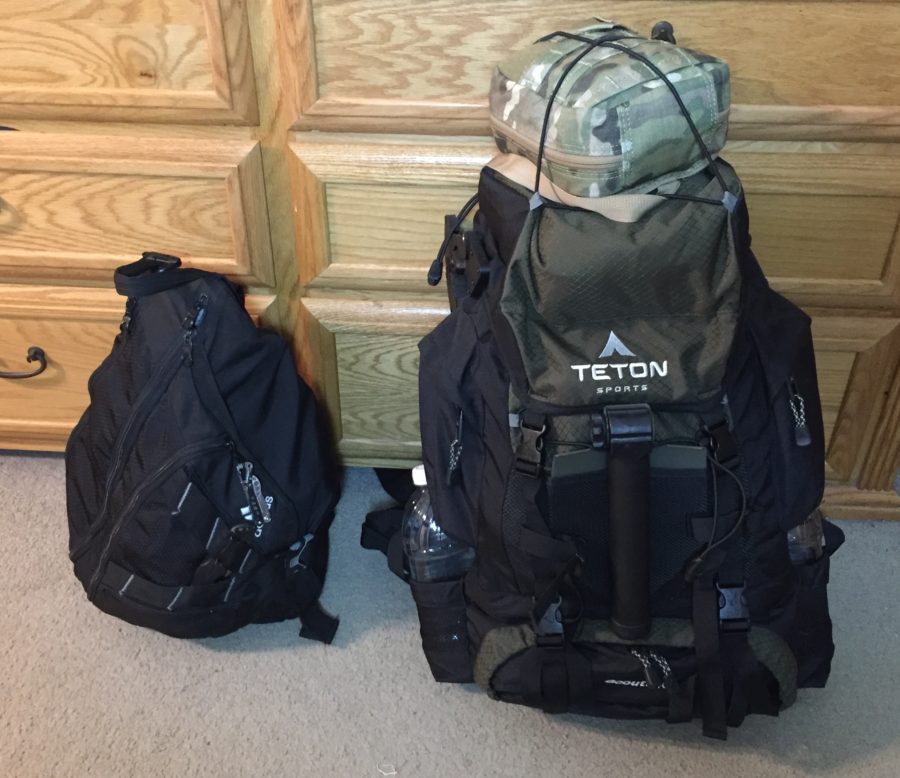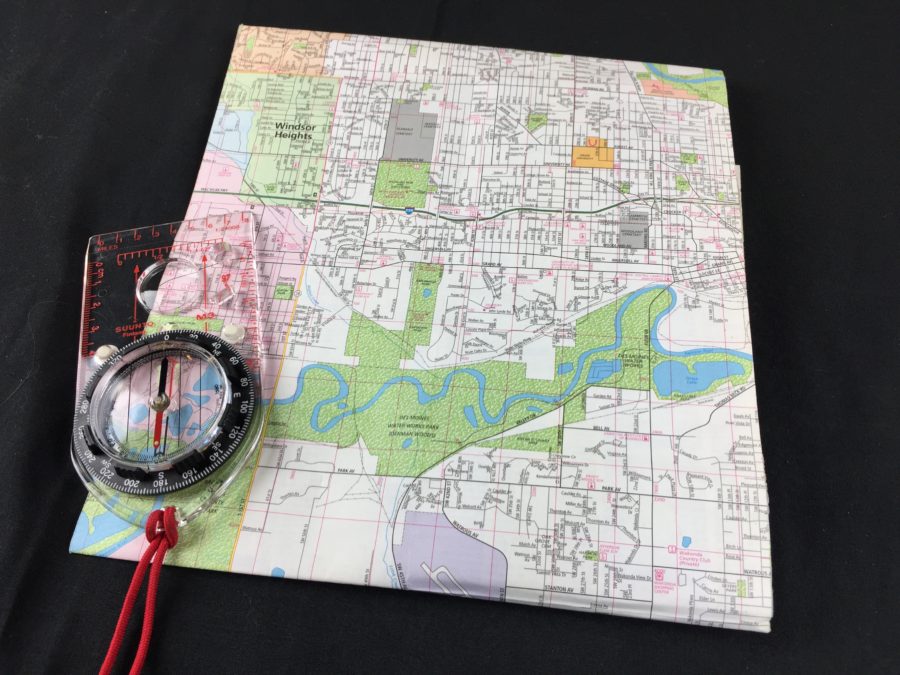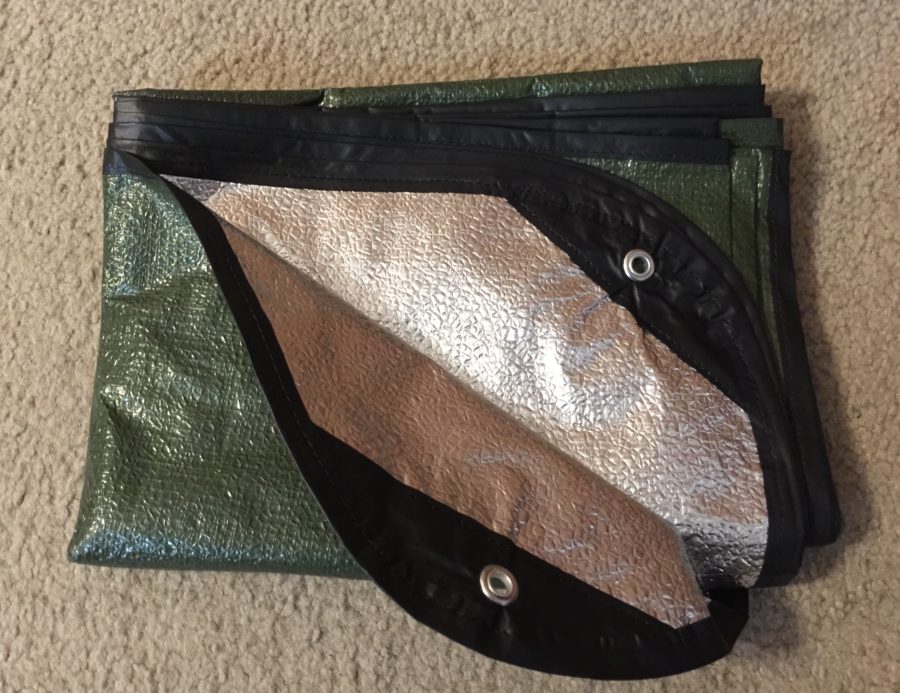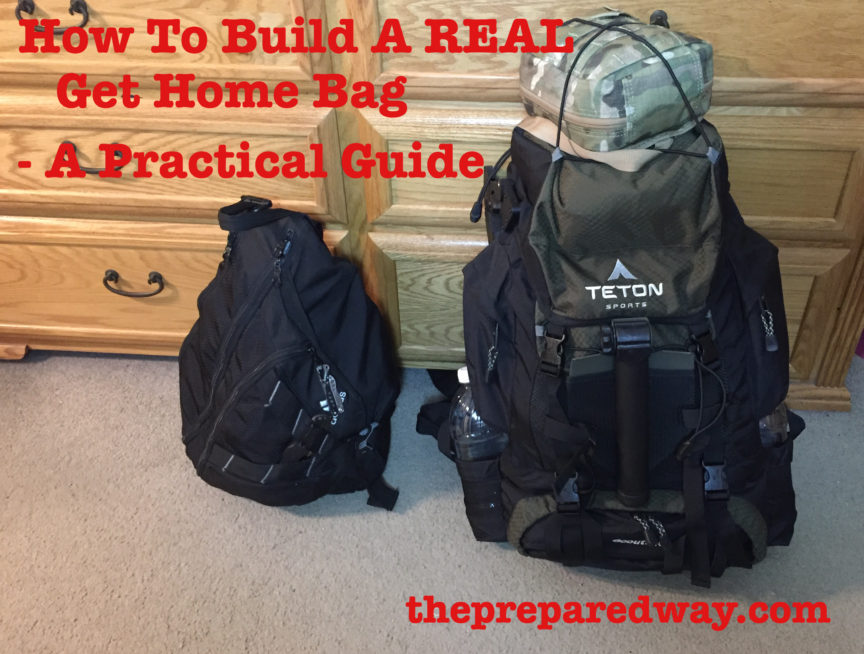Whether natural or man made, you never know when a disaster will occur. I’ve discussed preparing a Bug Out Bag in a previous article but a Get Home Bag or Bailout Bag is a little different. The concept is similar, you are trying to get from Point A to Point B, but the contents and philosophy are a little different.
This article is Step #4 of my series; Practical Prepping For Beginners: A No-Nonsense Quick Start Guide, if you haven’t read Step #1 check it out here.
What Is A Get Home Bag And Why You Need One?
What is a Get Home Bag? A Get Home Bag is a watered down bug out bag. It should have the “Essentials” to get you home in the event of a disaster that impedes the normal transportation and communication infrastructure which overtaxes law enforcement and emergency services. You are on your own, there’s no calling an Uber, there’s no calling a friend and if you could they would not be able to get to you anyways.
Having a Get Home Bag is an important part of your disaster preparedness planning and philosophy.
Why do you need a Get Home Bag? If you work a basic 8 to 5 job then add your commute to that and you spend nearly half of an average day away from home. If you have your basic preps and your Bug Out Bag at home that’s great but what happens when things go sideways when you’re not near home? Having a few things with you can make your emergency trip home at best more pleasant, at worst barely possible.
Make a Plan
Before you can choose a bag and fill it with the equipment and supplies that will assist you in getting home safe and sound, you first need to assess your personal situation. Just like making a Bug Out Plan, you will have a better chance of success if you have a plan, especially if things go horribly wrong.
One of the main differences between a Bug Out Plan and a Get Home Plan is with a Bug Out Plan your Starting point is usually the same place, your home but with a Get Home Plan you may be at work, on the subway or on vacation. So you don’t truly know where you may have to start from and this makes it difficult to pack your bag. As a rule of thumb use the maximum distance you travel from your home regularly.
I always consider the worst case scenario, having to walk on foot all the way home. Whether you drive or use public transportation there’s always the possibility that you will not be able to count on that as your ticket home. Often panic evacuations lead to traffic jams and if the power grid is down no subways and no traffic lights equaling more traffic problems.
There are a few things you need to be thinking about when you are making your plan.
- How far are you from home?
- What obstacles or hazards might you encounter
? Do you have young children in school, daycare or after-school activities that you need to get before going home?- Is going home your best and safest option?
There are many different factors that you must consider when making your plan. My Get Home Plan is pretty simple with the exception of one possible hazard/obstacle.
I travel just about 20 miles from my home almost daily, so I set up my Get Home Bag for 24 hours. Under average conditions and my current physical conditioning, I should be able to hike home in 6-7 hours. By planning for 24 hours, I have given myself a buffer to allow for unforeseen situations. I also have a friend that lives about halfway between, this allows for shelter and resupply if needed, so my Get Home Bag is packed light. My thought is, I have a lot of ground to cover so the less I have to carry the faster I can travel and with few anticipated threats and/or obstacles I can afford to travel lighter.
The only real hazard that I have on my route is a small river. In order to get home, I must cross this river, so I’ve scouted all of the possible crossings that don’t take me too far off my primary route just in case of flooding or other reasons, would make the main bridge impossible to cross. One thing that makes my plan easier than many others, is that most of the route that I have planned is in suburban and rural areas so I don’t expect to run into traffic jams or crowds of people.
Types Of Get Home Bags
There are two main types of
EDC – Get Home Bag
An EDC type Get Home Bag will be something you carry with you every day. This will be for people who may not have a vehicle that they use for daily transportation. If you commute via public transportation and will need to carry your bag with you during your commute. This type of bag will also work for those who only travel a short distance from home.

The Bag
When choosing a bag for an EDC Get Home Bag you should try to blend in. Don’t go cheap, you will want a quality bag if you are going to be using it every day. What makes a quality bag? Things to look for in a quality bag:
- 1000D Nylon
- Double or Triple Stitched
- Heavy Duty Zippers (YKK When Possible)
- Sternum Strap (Standard 2 Strap Backpack)
- Waist Strap
- Large Grab Handle
- Divided For Easy Organization
There are two basic types of packs that work for an EDC Get Home Bag. The standard “school” type with 2 straps and the single strap “Sling” bag. These both have there pros and cons.
STANDARD BACKPACKS: These work better when hauling heavier loads over longer distances because of better load distribution and tend to maximize useable space. Where they are lacking is where the sling bag excels, personal security.
SLING BAGS: Sling bags are great for those who use public transportation, it allows you to easily transition the bag from your back to your front and back again without taking it off. Being able to quickly and easily transition is perfect for preventing pickpockets from gaining access to your bag while in crowded lines, buses, subways, etc. It also makes it easy to sit without having to take your pack off, there is no chance for someone to grab your bag and run.
One drawback is with a single strap the weight distribution is all on one side, making longer trips with a heavier bag uncomfortable, to say the least. If you get a sling bag make sure the strap is WIDE. Another drawback is the shape, they tend to be triangular which reduces the overall capacity and can make it difficult to carry larger laptops. The sling bag that I love and have used for many years now is the Adidas Rydell Sling Backpack, which unfortunately has been discontinued for a while now.
The Contents
Because you will be carrying this bag with you everywhere its contents may be somewhat restricted. It also needs to be packed light, you may also need to carry other things like your laptop, papers, and/or your lunch.

TRAUMA/FIRST AID KIT: You don’t necessarily need a full trauma kit but I do recommend it. If you need to go the minimalist route you should at least carry a tourniquet or two but more is better and don’t forget to get some basic first aid skills so you can put that kit to use if need. For a full break down of my recommended Trauma Kit check out my article How To Build A Bug Out Bag/Kit – A Practical Guild, Trauma kits are one of the first things I discuss in that article.
1 LITER WATER BOTTLE: Having a water bottle isn’t out of place these days, more and more people understand the importance of staying hydrated. Having a water bottle hanging on the side of your pack won’t seem out of the ordinary. If you foresee needing to boil water you may want to use a stainless steel or aluminum bottle otherwise a plastic or Nalgene bottle will work just fine.
WATER FILTER and PURIFICATION TABLETS: If 1 liter of water is not enough to get you home you will want to resupply. This means making sure the water you collect is safe for consumption. You will want to eliminate any viruses using purification tablets and filter the water to eliminate any bacteria and other materials.
SILLCOCK KEY: If you are in a suburban or rural area this may not be as important to you, but in urban areas, this is a must. A sillcock key will allow you to get water from protected water valves that don’t have handles.
MEAL REPLACEMENT/PROTEIN BARS: Your meal plan is simple, on the go fuel. Meal replacement bars are perfect for this. A quality bar will have a good mix of carbs and protein to keep you going strong when it counts. If you want something you can just toss in your bag and forget about, you can always get a brick of emergency rations. If you get the right ones they aren’t too bad and have a shelf life of 5 years.
PERSONAL PROTECTION: This is a difficult area to cover because the types of defensive tools you can own and carry, varies so much depending on your country, state, and local laws and ordinances. Whatever you choose make sure that you get training and become proficient with the tools you have at your disposal.
MAP AND COMPASS: If you are in a familiar area then you may not need a map and compass but even if you know your area well, once the sun goes down everything changes.

HEADLAMP: This is a must if you have to travel at night or if you need to go hands-free. Make sure to pack extra batteries, I recommend using only lithium batteries, they don’t rupture and leak like standard batteries often will.
TACTICAL FLASHLIGHT: Although a headlamp is nice, a quality flashlight can extend your visibility far beyond that of a headlamp. I prefer a light that has high and low settings, one for identifying people or things and one for longer run time. Again, remember extra lithium batteries.
VS17 SIGNAL PANEL: Great for signaling for help. These are great for signaling rescue helicopters if you become stranded due to flooding or impassable terrain.
AM/FM/WEATHER RADIO: Just because cell phone towers are down or jammed up doesn’t mean that AM/FM broadcast radio is. There may be vital information being broadcast that may change your Get Home Plan. Information about your route or destination may change things dramatically.
WRITE IN THE RAIN PEN AND PAPER: This will allow you to write down important information or notes about your situation, info you heard on the radio and more.
SUNGLASSES/SAFETY GLASSES: Our vision is one of our most important senses. Our sight allows us to navigate our environment so protecting your eyes is of utmost importance.
GLOVES: You don’t know what you might encounter on your trip home and having a pair of leather work gloves will protect your hands from injuries.
N95 MASK: In the survival rule of 3’s you can only go 3 minutes without air and having the ability to filter the air you need is important for protecting yourself from dust and other airborne hazards.
FIRE KIT: Even if you are in the concrete jungle having the ability to make fire can save your life. You need two things, an ignition source and tinder. I like to have a couple of options for getting a fire started. First I like to have a Bic lighter or two in a waterproof container and for tinder, I prefer cotton balls soaked in Vaseline. With these, if you do your part, you have a good chance of making a fire even in adverse conditions
MULTI-TOOL: Having a quality general purpose multi-tool can and will solve many different problems and is worth the weight.
POCKET KNIFE WITH GLASS-BREAKER: Pocket knives have many uses you should leave home without one. Get a high-quality folder with a carbide glass breaker, don’t go cheap or you may find out how difficult it can be to break out a car window.
550 PARACORD: With hundreds of uses, having at least 100 feet will come in handy but having more won’t hurt.
MONEY: During a disaster, you can’t expect power and communication infrastructure to be operational. Having some cash can be a lifesaver. Keep a mix of smaller bills so it’s easy to make
RAIN PONCHO: A military style poncho that has grommets can perform double duty, it can be used for protection from the rain or as a makeshift shelter.

EMERGENCY BLANKET: I prefer the heavyweight mylar blanket that has eyelets so it can double as a tarp but the lightweight ones are very small and you can easily carry a couple of them. You can use the heavy one for shelter, one to insulate you from the ground and one to wrap up in to stay warm.
HYGIENE KIT: You’re just going from point A to point B so keep it simple. I recommend a small roll of toilet paper, some wet wipes and a small bottle of hand sanitizer.
WALKING OR HIKING SHOES: If you don’t wear shoes or boots that you can walk home in, you need to pack some or you may pay the price with blisters or even a fracture. You just need something that you know will get you home. Also, don’t forget to pack some wool socks inside those shoes. Wool will pull moisture away from your skin and will keep your feet warm even when wet.
SEASONAL CLOTHING: This is something that will vary depending on your location and will need to be adjusted with the seasons. In places that have large swings in temperature in the spring and fall. I recommend mixing and matching different parts of the military’s PCU/ECWCS clothing systems or finding civilian versions of those clothing systems. These provide excellent protection wet or dry with minimal bulk. Don’t forget that cold weather hat and gloves as well.
HAND AND FOOT WARMERS: Also for those who live where the temps can dip low, hand and foot warmers can keep frostbite at bay or give those cold fingers some dexterity when you need it.
PERSONAL ITEMS: If you have items like eyeglasses or medications that you need, don’t forget to keep extras in your bag.
Vehicle – Get Home Bags
Having a Get Home Bag for your vehicle will allow you to have a larger bag and a larger bag will allow you to carry more supplies. The farther from home you travel the more supplies you may need. If you are traveling a long distance from home and you have enough room you may want to just bring your Bug Out Bag (if you have one) or you need to adjust your Get Home Bag accordingly.
The Bag and Contents
This type of bag is very similar to a bug out bag but is usually packed lighter. When choosing a bag for your Vehicle Get Home Bag your options are pretty open. You are only limited by either how much you want to carry or by how much room you have in your vehicle to store a larger bag.
Thoughts on Fitness
I feel that speed is one of the most important factors when you are trying to get home during an emergency or disaster. Getting out of the affected area as fast as possible and getting to the safety of your home should be your top priority. A part of preparedness that most do not talk about is fitness. If you have a Get Home Bag that you may have to carry home from many miles away, can you do it? Do you have the physical conditioning to walk that far with your pack? You need to be honest with yourself and if the answer is no, you should make the necessary changes in your lifestyle make sure you can get home when it matters most.
Final Thoughts
Remember that the list above is a list of recommended items and not an end all, be all list. Everyone’s needs are different, you may add things that you feel your individual situation calls for and remove things that you feel you don’t need.


